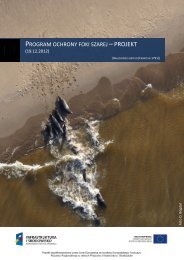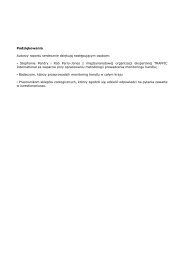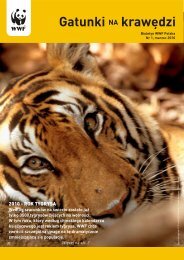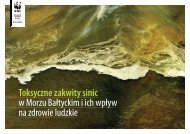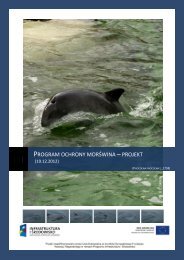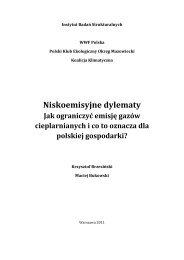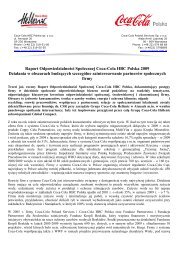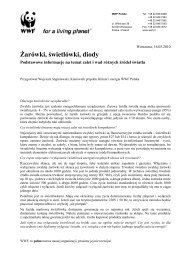COLLECTING GHOST NETS IN THE BALTIC SEA - WWF
COLLECTING GHOST NETS IN THE BALTIC SEA - WWF
COLLECTING GHOST NETS IN THE BALTIC SEA - WWF
You also want an ePaper? Increase the reach of your titles
YUMPU automatically turns print PDFs into web optimized ePapers that Google loves.
1. Introduction<br />
The pilot project titled “Collecting ghost nets in the<br />
Baltic Sea” 1 implemented in Poland in 2011 demonstrated<br />
beyond any doubt the need to continue the<br />
undertaking and to extend its spatial scope to<br />
include the waters of other Baltic region countries.<br />
In 2012 Lithuania joined the efforts to remove ghost<br />
nets from the Baltic Sea.<br />
First, an international panel of experts from both<br />
countries was formed, with the intention of collecting<br />
comprehensive information on the issue of<br />
ghost nets remaining at sea beyond any control and<br />
supporting the Project Manager and national coordinators<br />
in the net removal efforts. In summer 2012,<br />
actions at sea were carried out, involving retrieving<br />
nets from the sea bottom and removing them from<br />
shipwrecks. In addition to these activities, an<br />
interactive map of “hooks” in the Baltic Sea was<br />
created, indicating the locations of shipwrecks and<br />
other objects remaining on the sea bottom that<br />
constitute obstacles for trawling.<br />
Despite the increasingly common use of more precise<br />
fishing navigation employing the GPS system<br />
damaged net fragments, often including accessories<br />
(ropes, weights, chains etc.), continue to accumulate<br />
on shipwrecks and similar obstructions<br />
(often unmarked on nautical charts). As well as<br />
retaining their fishing capacity, thus reducing the<br />
use of fish resources by people, they constitute<br />
a danger for submarine tourism and may constitute<br />
a direct risk to life 2 .<br />
This report is an overview of the most important<br />
aspects of the phenomenon of ghost nets and legal<br />
regulations related to polluting the sea with fishing<br />
gear, based on the literature and observations<br />
made in the course of the project.<br />
1<br />
<strong>WWF</strong> Poland 2011: Efekty ekologiczne działań przeprowadzonych<br />
w ramach projektu pilotażowego “Usuwanie zalegających<br />
sieci z Bałtyku” (Environmental effects of the activities in the<br />
framework of the pilot project entitled “Collecting ghost nets<br />
in the Baltic Sea”). Final report. http://www.wwf.pl.<br />
2<br />
Urząd Morski w Gdyni (Maritime Office in Gdynia) 2006: Informacja<br />
o zbiorowym wypadku śmiertelnym nurków na wraku<br />
statku „Goya” w dniu 21 kwietnia 2003 r. (Report on a collective<br />
fatal accident on the wreck of ”Goya” on 21 April 2003). http://<br />
www.umgdy.gov.pl/pium/jednostka?menuId=5991&kodJednostki<br />
=abul4zaqt2.6h27ldaqt1&id=19702.<br />
The pilot project titled<br />
“Collecting ghost nets in the Baltic Sea”<br />
implemented in Poland in 2011<br />
demonstrated beyond any doubt the need<br />
to continue the undertaking and to extend<br />
its spatial scope to include the waters<br />
of other Baltic region countries.<br />
1.1. The phenomenon of ghost nets<br />
– literature review with particular<br />
regard to the Baltic Sea<br />
Regardless of the scale on which the issue of ghost<br />
nets is considered – global, European or limited to<br />
the Baltic region – it remains in the sphere of the<br />
problem of marine debris. This issue with regard to<br />
the contamination of seas and oceans has been<br />
addressed in a report by UNEP-FAO 3 , in an American<br />
study concerned with tackling marine debris in<br />
the 21st century 4 , and in the European Commission<br />
study of October 2012 5 . These three major sources<br />
of information on the phenomenon of ghost nets<br />
show a comprehensive approach to the issue,<br />
beginning with the root of the phenomenon, i.e. the<br />
common use of plastics in the production of fishing<br />
gears, through a description of different types of<br />
marine fishery generating wastes that pose the<br />
greatest danger for the environment, together with<br />
an analysis of the effect of these wastes on the<br />
resources of commercially exploited sea organisms,<br />
and ending with identification of possible preventive<br />
measures, as well as methods of retrieval and disposal<br />
of net fragments and other components used<br />
by fishing fleets all over the world. In view of the<br />
universal character of the theoretical considerations<br />
contained in these studies and the proposed practical<br />
solutions, it may be assumed that a similar<br />
approach to the issue of ghost nets in the Baltic<br />
3<br />
Macfadyen, G. et al. 2009: Abandoned, lost or otherwise<br />
discarded fishing gear. UNEP Regional Seas Reports and<br />
Studies, No. 185; FAO Fisheries and Aquaculture Technical<br />
Paper, No. 523, Rome UNEP/FAO.<br />
4<br />
National Research Council. 2008. Tackling Marine Debris in the<br />
21st Century. National Academy Press, Washington, DC.<br />
5<br />
COMMISSION STAFF WORK<strong>IN</strong>G DOCUMENT SWD (2012)<br />
365 F<strong>IN</strong>AL, Brussels, 31.10.2012. Overview of EU policies,<br />
legislation and initiatives related to marine litter.<br />
4 <strong>COLLECT<strong>IN</strong>G</strong> <strong>GHOST</strong> <strong>NETS</strong> <strong>IN</strong> <strong>THE</strong> <strong>BALTIC</strong> <strong>SEA</strong>



